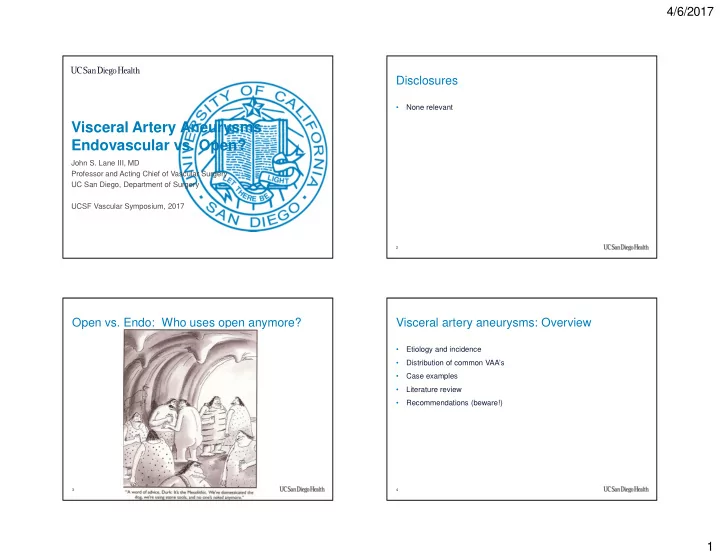

4/6/2017 Disclosures • None relevant Visceral Artery Aneurysms Endovascular vs. Open? John S. Lane III, MD Professor and Acting Chief of Vascular Surgery UC San Diego, Department of Surgery UCSF Vascular Symposium, 2017 2 Open vs. Endo: Who uses open anymore? Visceral artery aneurysms: Overview • Etiology and incidence • Distribution of common VAA’s • Case examples • Literature review • Recommendations (beware!) 3 4 1
4/6/2017 Visceral Artery Aneurysms (VAAs) • Incidence: 0.1%-1% • Most are found incidentally • 22% present emergently: Rupture or GI bleeding, abdominal apoplexy • Mortality after rupture depends on location Class Rupture Risk Hepatic Artery 60 - 80% Superior Mesenteric Artery 38% Celiac Artery 7% Pancreaticoduodenal Artery 68% Gastroduodenal Artery 56% Gastroepiploic Artery 90% 5 6 Splenic Artery Aneurysms Splenic Artery Aneurysms • Most common VAA: 60% • Presentation • Most are asymptomatic: incidentally found in 1% of angiograms, CTA • Asymptomatic • Female predominance (4x) • Abdominal pain, apoplexy • Risk factors: FMD, portal HTN, pregnancy/multiparous, AS, Liver tx • “Double-rupture” phenomena (rupture into lesser sac) • Etiology: unknown, secondary to trauma, pancreatitis, collagen vascular • Indications for treatment • Morphology: 72% true aneurysms/28% PSA • Size >2cm • Saccular>fusiform, occur at bifurcations • Rapid enlargement • Rupture risk • Symptomatic • Overall 2%, pregnancy 50% (66% in third trimester) • Women of child-bearing age • Mortality: maternal 70%, fetal 90%, surgical 40% • Non-operative treatment: low risk groups Stanley JC: Mesenteric arterial occlusive and aneurysmal disease. Cardiol Clin. 20(4):611- Lakin RO, Bena JF, Sarac TP, Shah S, Krajewski LP, Srivastava SD, Clair DG, Kashyap VS. The 7 8 622 2002 contemporary management of splenic artery aneurysms. J Vasc Surg. 2011 Apr;53(4):958-64 2
4/6/2017 Splenic Artery Aneurysm treatment Splenic aneurysm • Open Surgical Repair • 55 year old asymptomatic woman • Splenectomy (distal/infrasplenic) • Undergoing experimental chemotherapy for lymphoma • Proximal & distal ligation (proximal/splenic preservation) • Incidentally found 2.5cm inflammatory aneurysm found on CT scan • Aneurysm exclusion with arterial reconstruction • Endovascular Repair • Coil embolization • Occlusion or with uncovered stent • Cyanoacrolate glue • Covered Stent 9 10 11 12 3
4/6/2017 Celiac Artery Aneurysms • 4% of VAA (incidence 1 in 8000) • Associated with atherosclerosis, other VAA (40% concordance) • 10-20% rupture rate, 50% mortality rate • No size threshold correlated with rupture • Repair all sizes recommended • Open: aneurysm resection with reconstruction (interposition, EA, re-implantation) • Endovascular: covered stent, coil 13 14 Superior Mesenteric Artery Aneurysms SMA aneurysms treatment • Open repair • 5.5% of visceral artery aneurysms • Interposition, EA reconstruction, re-implantation • Incidence 1 in 12,000 to 1 in 19,000 • Infection, involvement of branch • Most commonly infectious etiology (septic embolus) vessels, acute ischemia (trauma) • Bacterial endocarditis and IVDU • Endovascular • Medial degeneration, arterial dissection • Stent graft of SMA origin • PSA: connective tissue disease, pancreatitis, trauma • Coiling of minor branches • Mostly symptomatic: colicky pain, intestinal angina, weight loss in 70- 90% • Rupture rate 38% to 50%, Mortality 30- 90% • Treatment: symptomatic, infection, >2cm 15 16 4
4/6/2017 Hepatic Artery Aneurysms Hepatic artery aneurysm treatment • Incidence < 0.4% in general population autopsy studies • Common hepatic (proximal to GDA) • 20% of VAA’s • Open ligation/reconstruction Male predominance, 6 th decade • • Endovascular coiling/stent • Etiology: AS, Medial degeneration, trauma, mycotic, PAN • Proper hepatic (distal to GDA) • 80% extrahepatic, 20% intrahepatic • Open bypass • Rupture rate (unknown) 60-80%; mortality 35% • Endovascular stent • Majority asymptomatic • Intrahepatic • Quincke’s triad: RUQ pain, obstructive jaundice, hemobilia • Open partial hepatectomy • Treatment recommendations: >2cm, symptomatic, infected PSA, PAN • Endovascular coils (minor branch) • Infectious: resection +/- reconstruction 17 18 Hepatic artery aneurysm • 85 year year old man with 6.2 cm asymptomatic hepatic artery aneurysm • Incidentally found on outside CT scan • No jaundice, abdominal pain, hematochezia • PMH: smoking, COPD, hyperlipidemia • PSH: open cholecystectomy 35 year ago 19 20 5
4/6/2017 21 22 Literature review: Endo or Open? • 2003 – 2013 • 261 patients 181 VAA: 77 ruptured, 104 intact Shukla AJ, Eid R, Fish L, Avgerinos E, Marone L, Makaroun M, Chaer RA. Contemporary outcomes of intact and 23 27 ruptured visceral artery aneurysms. J Vasc Surg 2015 Jun;61(6): 1442-7 6
4/6/2017 Shukla et al. • Intact visceral artery aneurysms have equivalent survival when treated with endovascular or open techniques • Ruptured visceral artery aneurysms have improved overall and aneurysm-related survival when treated with endovascular approach Shukla AJ, Eid R, Fish L, Avgerinos E, Marone L, Makaroun M, Chaer RA. Contemporary outcomes of intact and 28 29 ruptured visceral artery aneurysms. J Vasc Surg 2015 Jun;61(6): 1442-7 Summary Let’s try a catheter next time… • Visceral artery aneursyms are a rare clinical entity (0.1-1%) • Diverse distribution (splenic > hepatic > SMA > celiac > other) • Often asymptomatic, found incidentally • Rupture risk and mortality depend on location and clinical presentation • Open surgery remains the goal standard of treatment • Aneurysm resection, ligation, +/- arterial reconstruction • Preferred method for infection, involvement of branch vessels • Endovascular techniques have become more widespread in treatment • Stent grafts, open cell with coils, embolization, glue • Equivalent durability for intact aneurysm repair • Improved survival for ruptured VAA (selection bias?) 30 31 7
Recommend
More recommend